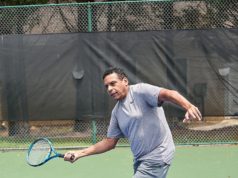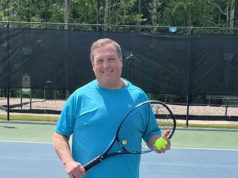By Neeru Jayanthi, M.D., Director, Emory Tennis Medicine Program
It’s common for adult tennis players to feel that their best tennis is behind them. Some players complain they are slower, get injured more, and don’t get to play as much. I have been playing tennis competitively for nearly 40 years, and I have felt all those same things. However, at 51 years old, I still feel that my BEST tennis may be AHEAD of me. As a sports and tennis medicine physician, I do recognize that we haven’t developed an “anti-aging” formula, but there are a number of reasons that it may be possible to extend your competitive tennis career and take advantage of the many adult competitive tennis opportunities.
I’ve been so excited and impressed with the number of high-quality tennis opportunities for us “aging” tennis players. These include ALTA senior divisions; senior local, regional, and national tournaments; USTA 40+ and senior divisions; playing in open leagues (to show those younger players you still “got it”); and playing with family. There are several ways that you can have even better tennis experiences as you get older!
Health benefits
Tennis is the healthiest of all sports, according to some high-quality studies. Playing tennis or racquet sports regularly (at least three hours/week) can reduce the risk of death by 47 percent when compared to sedentary activities. This was evaluated in a published study of >80,000 adults, controlling for many other factors. More specifically, the Copenhagen Heart Study, published in Mayo Clinic Proceedings, of 9,000 adults who play tennis regularly live 9.7 years longer than those that don’t play tennis and are sedentary. No other sport comes close to this type of health benefit, and I believe this is not only due to the cardiorespiratory benefit of tennis, but because of the strong social dynamics of tennis and particularly league tennis.
Rehabilitation/fitness
Although progressive, degenerative changes of joints and tendons may be in large part unavoidable, the data is clear that targeted and comprehensive rehabilitation programs can treat and improve the large majority of the conditions that adult tennis players may encounter. Specifically, in hip and knee osteoarthritis, rehabilitation and water-based, low-impact exercise programs reduce symptoms. In fact, knee pain ratings are also lower on clay courts than hard courts. Most degenerative tendon problems (tennis/golfer’s elbow, Achilles, rotator cuff, patellar tendon) have dedicated rehabilitation and strengthening programs, which have been shown to be effective in all of these conditions. This may be complemented with additional interventions (biologic injections, and/or other procedures or surgeries) only when necessary in a minority of patients. Rehabilitation may be focused (eccentric) strengthening for certain areas such as Achilles tendon, and more complex for other areas, such as rotator cuff. Preparing the body through rehabilitation programs and optimizing fitness may prepare a player for the demands of competitive tennis (regardless of age).
Biologic treatments (regenerative medicine)
Many of us may not be able to avoid the degenerative progression of our joints and tendons. While this is a normal aging process that may become symptomatic and inhibit playing tennis for some, there may be some potential options to possibly delay this progression. In the appropriate patients who meet criteria, the use of a patient’s own cells through injection into specific joints or tendons called Biologic treatments or regenerative medicine may offer a non-surgical alternative for extending tennis participation. Limiting treatment options, such as steroid injections (which may advance degeneration) and elective surgical options when appropriate, may potentially help extend a career, while joint replacement surgery (for arthritis) and other surgeries may be better choices for advanced degenerative disease. While there are some encouraging studies and anecdotal results from these treatments, it is important to understand the specific indications for treatments such as PRP (Platelet Rich Plasma) or stem cell injections (and when these treatments may NOT be effective). Common areas and indications for tennis players based on our experience and research may include the knee joint and degenerative tendons (Table 1): While these treatments may have promise for some players, they do not help all players. A detailed discussion about your specific treatment options, including traditional treatments such as rehabilitation or surgery, must be discussed with your physician.
Tennis 10+ warm up/cool down program
We’ve previously published in Net News about a tennis-specific warm up and cool down program that we created and researched in >350 adult recreational league players. The Tennis 10+ program (https://bit.ly/3KfeAR4) is essentially 10 exercises (six dynamic warm up, four cool down) that can be performed on court prior to and after playing tennis in just minutes. Our preliminary data suggest that doing this five-minute warmup (and five-minute cool down) exercise program may reduce the rate of injuries and severity of injuries in those who are compliant (i.e., >50 percent of the time). As a league captain myself, I know that one of the most common reasons for unavailability is injury, which may be preventable in some situations. I encourage EVERY adult recreational tennis player to make sure they do the Tennis 10+ warmup/cool down program to help reduce injuries and absences from league tennis!
While I sometimes tell patients that there are only two things that get better with age (wine and cheese), it is entirely possible to continue to have even more benefit from playing tennis after 50 years old (or as you age). Try to remember the immense health benefits, utilization of rehabilitation/fitness to treat and reduce injuries, consider appropriate biologic treatment options for those proper indications, and do the Tennis 10+ warm up/cool down program before and after you play. I hope you enjoy playing and competing in tennis as you get older as much as I do!




